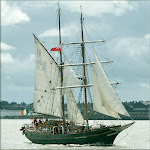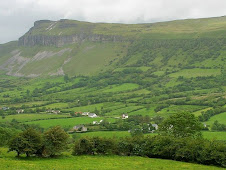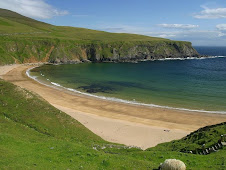 A week ago I wrote my third article about the loss of the Irish sail training vessel Asgard II (seen here moored at Cork in 2003), which sank off the French coast in the Bay of Biscay on September 11th. (see my entry of that day)
A week ago I wrote my third article about the loss of the Irish sail training vessel Asgard II (seen here moored at Cork in 2003), which sank off the French coast in the Bay of Biscay on September 11th. (see my entry of that day)One of my readers - Ronnie - has left a comment with this post and asked 5 questions, which I will answer below to the best of my knowledge and ability.
1) Approx How much would it cost to buy the Prince William?
This is a very good question, but at this point in time I don't have a precise answer for it. I will make further inquiries, and should I be given a specific sum, I will come back to you in a later post.
In general, vessels of this kind and size don't come cheap, especially if they are in good condition, which the Prince William certainly is. There is currently another brig on the market - one that is older than the Prince William and based in Germany - and her owners are looking for € 2.4 million. However, if they can get that amount in the present climate of world-wide economic crisis and recession is somewhat doubtful. Like with everything else, the market forces of supply and demand determine the price for a ship or vessel. If an owner is in desperate need of cash, he might sell at a price below the actual value, and a buyer in urgent need of a vessel might pay more than he would under normal conditions. As things are now, it is more a buyer's market. So negotiating and even a bit of haggling might well be worth one's while.
2) Is there superstitions with sailing on a vessel that have sunk before?
There are many people who have superstitions of all sorts and kinds, and the sailing community is no exception to that. However, the kind of superstitions many sailors had in less enlightened times in the past have almost all disappered from today's modern sailing community. At least I have not encountered any of them in more than thirty years at sea.
One might be thinking of things like the 'Klabautermann' or the ship's 'kobold', or perhaps of the old tale of the sacred Albatros, who would bring doom to a ship if he was killed. Very well-known is also the superstition of the 'Jonah', a crew member or passenger on board who brings the ship bad luck.
And there is the even older superstition that a woman on board will attract bad spirits to a vessel and its crew.
All those were the products of times when sailors were widely uneducated and often illiterate, but to a great extend influenced by religious believes and doctrines, superstitions and old sagas and tales. Today's sailors are modern people, and live in a world of information and technology. Thus these old superstitions are gone for good.
This goes especially for the idea that a woman on board means bad luck. There are many women in all sorts of ships and vessels these days, in passenger ships, ferries and cruise liners, and they serve with equal rights in most of the world's navies. (Norway has even a female officer in charge of one of their submarines now.) And on many modern sail training vessels the number of female trainees often exceeds the number of their male crew mates.
However, the superstition you mention in particular still exists to a certain extend, though I would see it more as a fear or general safety concern than a traditional superstition. There are people who would not buy and drive a second-hand car that was involved in an accident, or buy a house damaged by a fire. The same goes for ships. Some people would not sail in a ship that had a fire or major accident, and this goes especially for vessels put back into service after having sunk and being subsequently salvaged and repaired.
Personally I do not share such fears. Modern technology is very advanced, and any vessel that had the bad luck to founder - usually under heavy weather conditons - and is salvaged and repaired, will be as safe as any other. In fact, one can assume that the owners will make sure that all possible safety measures are put in place, perhaps even more than the ship had before, to avoid a repeat of the traumatic event as much as it possible.
There is never a 100% guarantee, and any ship or vessel can get into trouble if the conditions are bad enough. And of course it is a free world we live in, so no-one is forced to sail in a vessel that has sunk before.
3) Is there problems that can occur later after a vessel has been recovered and repaired?
Well, as I said already above, there is never a 100% guarantee, and any ship or vessel can get into trouble if the conditions are bad enough. If a sunken vessel is deemed fit to be raised and repaired, it means that it is still in good enough condition for further service. Otherwise one would not spend the time, energy and money on it.
When repairs are carried out, they are done professionally and to the best of people's ability. Often a salvaged vessel is modernised and further improved in the process of repair, to make it stronger and better and avoid future calamities.
For the general stability and service ability of a ship it also depends to a certain extent on the conditions under which she sank, which parts were damaged, how badly and by what cause.
For example, ships that were torpedoed or ran onto a mine during a war would have substantial structural damage to the hull. Even after proper and professional repair that can mean a certain structural vulnerability of the vessel. Nevertheless many ships who suffered such a fate have been raised, repaired and put back into service, some in their previous role, others were given less hazardous duties (e.g. as training ships, coastal patrol vessels or storage hulks).
In case of the Asgard II it appears that she is still in pretty good shape and almost undamaged. She sits upright on the bottom of the sea, which means that her masts should be alright, too. Inspection has found light damage to one hull panel, but it is not certain if that damage occurred before and was the reason for her sinking, or if it happened when she hit the seabed.
I am no shipwright or engineer, but from what I know a salvage and repair should be possible and not even too difficult. And after a proper repair I would deem her as safe and stable as any other vessel.
4) Why the sailing community would prefer to see her fixed and not replaced with a larger vessel offering greater training opportunities?
The reasons for that are mainly sentimemtal. There are certainly people who would favour a larger vessel as replacement for Asgard II, as it would indeed offer more places for trainees. When Asgard II was built in 1981, sail training - in Ireland as well as anywhere else - was not as popular as it is now. So the vessel was designed for the needs of a small country like Ireland. At the time no-one would have expected that the tall ships would return from the obscurity of history and become very popular again.
If we would build a sail training vessel for Ireland today - and perhaps we still might have to do that if a salvage of Asgard II is not possible or financially not viable - it would naturally be of a larger size, most likely a brig or even a barque instead of a brigantine.
But one should not underestimate the sentimentalities of sailors. As much as superstitions have now disappeared from the seafaring community, we are still quite a sentimental lot. Each ship and vessel has her own personality, almost like a human being, and emotions are invested in the relationships sailors have with their vessel.
Asgard II has always been a 'happy ship' and was very popular with sailors and the general public alike. And this was not limited to Ireland. Quite the opposite. Even though we are an island and thus surrounded by the sea, the sailing community here is still relatively small.
But through her voyages around the world, visits to many foreign ports and participation in the international Tall Ships' Races the Asgard II has made many friends in many countries. They all were saddened by her sinking and would be very happy to see her salvaged and sail again.
There is also one other aspect that has to be taken into consideration. As the cause of the sinking of Asgard II is yet unknown and the circumstances - as far as we know them - are somewhat unusual, a full and close-up inspection of the vessel is very much desired, in order to establish without doubt what actually happened. This could well be attempted by divers, but it would be a lot more thorough when done by experts on the surface. For that a raising of the sunken vessel is a prerequisite.
5) Why do you think building a new vessel is not the favoured option for Coiste an Asgard?
This answer is easy: Money. As the Asgard II is of course insured, the costs for salvaging and repair would be a matter for the insurance underwriters. Thus the State and Coiste an Asgard would get their vessel back into service at almost no expense.
It also makes no sense to leave a perfectly operable vessel with only slight damage to rot at the bottom of the sea, where she would disintegrate over time and be lost forever.
The only real advantage the building or acquisition of a new - and larger - vessel would give is an increased number of training places. And this alone is not a strong argument with Coiste an Asgard.
In case a replacement for Asgard II would be needed, buying an existing vessel - like the above mentioned Prince William - would be preferred to building an entirely new one in Ireland. Again money is the main factor here, and there is also the element of time. Depending on type and size of the new vessel, and the shipyard chosen to build her, it could easily take years before she would put to sea.
This means a loss of income as well as a loss of skills and experience for Coiste an Asgard. And a new construction would undoubtedly be far more expensive than the purchase of an existing vessel, which would be ready to sail almost immediately after acquisition.
Given the current recession and world crisis, with good negotiations one might even be able to obtain a brig like Prince William second-hand for the money the insurance underwriters would have to pay out in case of a total loss.
Nevertheless, the best and also least expensive option remains a salvage and repair, and I am sure that Coiste an Asgard will do that, unless unforeseen technical problems should stand in the way.
Thank you for your questions, and I hope you will find my answers satisfactory. Keep reading this weblog for any further developments regarding Asgard II and other sailing matters. And feel free to ask any questions you have. They are as welcome as you are.
The Emerald Islander







































1 comment:
Hello,
My name is Arthur. I am Portuguese, writing from Portugal.
I was looking up the irish cutter "Wild Goose", in which I have met and sailed with Wallace Clark, and it was sad To hear from your blog that Asgard II was lost at sea, very much the same way Wild Goose.
I have sailed Asgard II from Lisbon to Dublin in March/Apri 98, across the Bay of Biscay, with a reasonable gale blowing. Faultless she was and imensely seaworthy. Look forward hearing news from Asgard on your Blog.
Cheers
Arthur
arthur.carvalho@rcarvalho.pt
Post a Comment